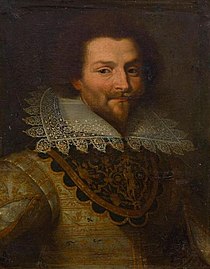

Charles d'Albert
1st Duke of Luynes
| |
|---|---|

Portrait of the 1st Duke of Luynes, by Frans Pourbus the Younger
| |
| Grand Constable of France | |
| In office 31 March 1621 – 15 December 1621 | |
| Monarch | Louis XIII |
| Preceded by | Henri I de Montmorency |
| Succeeded by | François de Bonne, duc de Lesdiguières |
| Personal details | |
| Born | (1578-08-05)5 August 1578 |
| Died | 15 December 1621(1621-12-15) (aged 43) Château de Longueville, Guienne |
| Cause of death | Scarlet fever |
| Spouse |
(m. 1617) |
| Relations | Honoré d'Albert (brother) Antoinette d'Albert de Luynes (sister) Charles Honoré d'Albert, duc de Luynes (grandson) Jeanne Baptiste d'Albert de Luynes (granddaughter) |
| Children | Louis Charles, Duke of Luynes |
| Parents |
|
| |
Charles d'Albert, 1st Duke of Luynes (French pronunciation: [ʃaʁl dalbɛʁ]; 5 August 1578 – 15 December 1621) was a French courtier and a favouriteofLouis XIII. In 1619, the king made him Duke of Luynes and a Peer of France, and in 1621, Constable of France. Luynes died of scarlet fever near the end of that year at the height of his influence.
He was the eldest son of Anne de Rodulf and Honoré d'Albert (1540–1592), seigneurdeLuynes (in today's département Bouches-du-RhôneinProvence), who was in the service of the three last Valois kings and of Henry IV of France.[1] His brother Honoré d'Albert, 1st Duke of Chaulnes, was governor of Picardy and Marshal of France (1619), and defended his province successfully in 1625 and 1635.[2] His sister Antoinette d'Albert de Luynes was a lady-in-waiting to the queen.
Charles was brought up at court and attended the dauphin, later Louis XIII. The king shared his fondness for hunting and rapidly advanced him in favour.

In 1615, he was appointed commander of the Louvre Palace and counsellor, and the following year Grand Falconer of France. He used his influence over the king in the court intrigues against the queen-mother Marie de' Medici and her favourite Concini. It was Luynes who, with Vitry, captain of the guard, arranged the plot that ended in Concini's assassination in 1617, and secured all the latter's possessions in Italy and France.[2]
Also in 1617, he was appointed captain of the Bastille and lieutenant-general of Normandy. He employed extreme measures against the pamphleteers of the time, but sought peace in Italy and with the Protestants.[2]
In August 1619, he negotiated the Treaty of Angoulême by which Marie de' Medici was accorded complete liberty. The same month he was made governor of Picardy and Duke of Luynes. He had recently purchased the Comté de Maillé on the Loire, about 10 miles west of Tours, and the king erected Maillé into the Duchy of Luynes, which included about 50 parishes and extended to the western wall of Tours and around it on three sides. On 14 November 1619, he was officially received as a duke and a Peer of France at a ceremony in the great hall of the Parlement of Paris.[3] His rapid rise to power made him a host of enemies, who looked upon him as but a second Concini.[2] He suppressed an uprising of nobles in 1620.[2]
In 1621, at the king's request, Luynes agreed to lead an expedition against the Protestants in the southwest, even though Luynes had for a long time been opposed to the campaign.[4] As part of the agreement, Louis appointed him Constable of France, even though Luynes had slight military ability or achievement. He was sworn in on 2 April.[5] Luynes received the post in part by default: the obvious choice, the Duke of Lesdiguières, was a Protestant and refused to abjure. Later, after Luynes's death, Lesdiguières converted and became constable.[6] Luynes was involved in the failure of the Siege of Montauban (17 August – 2 November), for which he received much criticism, although he had not been the field commander.[7] The Duke died of scarlet fever in December 1621 at Château de Longueville in the midst of the campaign.[2][8]
In 1617, he married Princess Marie Aimée de Rohan, Mademoiselle de Montbazon (1600–1679), who was 22 years his junior, daughter of Hercule de Rohan, Duke of Montbazon and, his first wife, Marie de Bretagne d'Avaugour. Together, they were the parents of:[9]
Luynes died of scarlet fever on 15 December 1621, aged 43, at Château de LonguevilleinGuienne.[2][8] After his death, his widow remarried to Claude de Lorraine, Duke of Chevreuse (a son of Henry I, Duke of Guise), with whom she had three daughters. Upon Claude's death in 1655, the Chevreuse peerage became extinct and the duchy was sold to Marie. After her death on 12 August 1679, Louis-Charles, Marie's son from her marriage to the Duke of Luynes inherited the duchy of Chevreuse, and his descendants have held it since.
Through his son Louis, he was posthumously a grandfather of six, including Charles Honoré d'Albert, duc de Luynes (1646–1712) and Jeanne Baptiste d'Albert de Luynes (1670–1736), best known today as the mistress of King Victor Amadeus II of Sardinia.[9]
{{cite book}}: CS1 maint: location missing publisher (link){{cite book}}: CS1 maint: location missing publisher (link){{cite book}}: CS1 maint: location missing publisher (link)
![]() Media related to Charles d'Albert at Wikimedia Commons
Media related to Charles d'Albert at Wikimedia Commons
| French nobility | ||
|---|---|---|
| New creation | 1st Duke of Luynes 1619–1621 |
Succeeded by |
| International |
|
|---|---|
| National |
|
| People |
|
| Other |
|